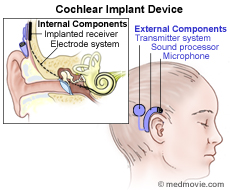


FDA Home Page | CDRH Home Page | Search | CDRH A-Z Index | Contact CDRH
![]()
   |
FDA Home Page | CDRH Home Page | Search | CDRH A-Z Index | Contact CDRH
|
 |
|
| • | View movie of the normal ear, ear with hearing loss, and cochlear implant procedure (Requires Flash Player - Download now) |
| • | Read text description of cochlear implants movie |
A cochlear implant is an implanted electronic hearing device, designed to produce useful hearing sensations to a person with severe to profound nerve deafness by electrically stimulating nerves inside the inner ear.
These implants usually consist of 2 main components:
Currently made devices have a magnet that holds the external system in place next to the implanted internal system. The external system may be worn entirely behind the ear or its parts may be worn in a pocket, belt pouch, or harness.
Cochlear implants are designed to help severely to profoundly deaf adults and children who get little or no benefit from hearing aids. Even individuals with severe or profound "nerve deafness" may be able to benefit from cochlear implants.
Many things determine the success of implantation. Some of them are:
A cochlear implant receives sound from the outside environment, processes it, and sends small electric currents near the auditory nerve. These electric currents activate the nerve, which then sends a signal to the brain. The brain learns to recognize this signal and the person experiences this as "hearing".
The cochlear implant somewhat simulates natural hearing, where sound creates an electric current that stimulates the auditory nerve. However, the result is not the same as normal hearing.
Current thinking is that the inner ear responds to sound by at least two separate ways.
One theory, the place theory, says the cochlea responds greater to a simple tone at one place along its length. Another theory is that the ear responds to the timing of the sound.
Researchers, following the place theory, devised implants that separated the sound into groups. For example, they sent the lower pitches to the area of the cochlea where it seemed more responsive to lower pitches. And they sent higher pitches to the area more responsive to high pitches. Thus, they used several channels and electrodes spaced out inside the cochlea. Since there were also timing theories, researchers devised implants that made the sound signals into pulses to see if the cochlea would respond better to various kinds of pulses.
Most modern cochlear implants are versatile, in that they are somewhat capable of being adjusted to respond to sound in various ways. Audiologists try a variety of adjustments to see what works best with a particular patient.
The first commercial devices were approved by the FDA in the mid-1980's. However, research with this device began in the 1950's.
![]()
CDRH Home Page | CDRH A-Z Index | Contact CDRH | Accessibility | Disclaimer
FDA Home Page | Search FDA Site | FDA A-Z Index | Contact FDA | HHS Home Page
Center for Devices and Radiological Health / CDRH